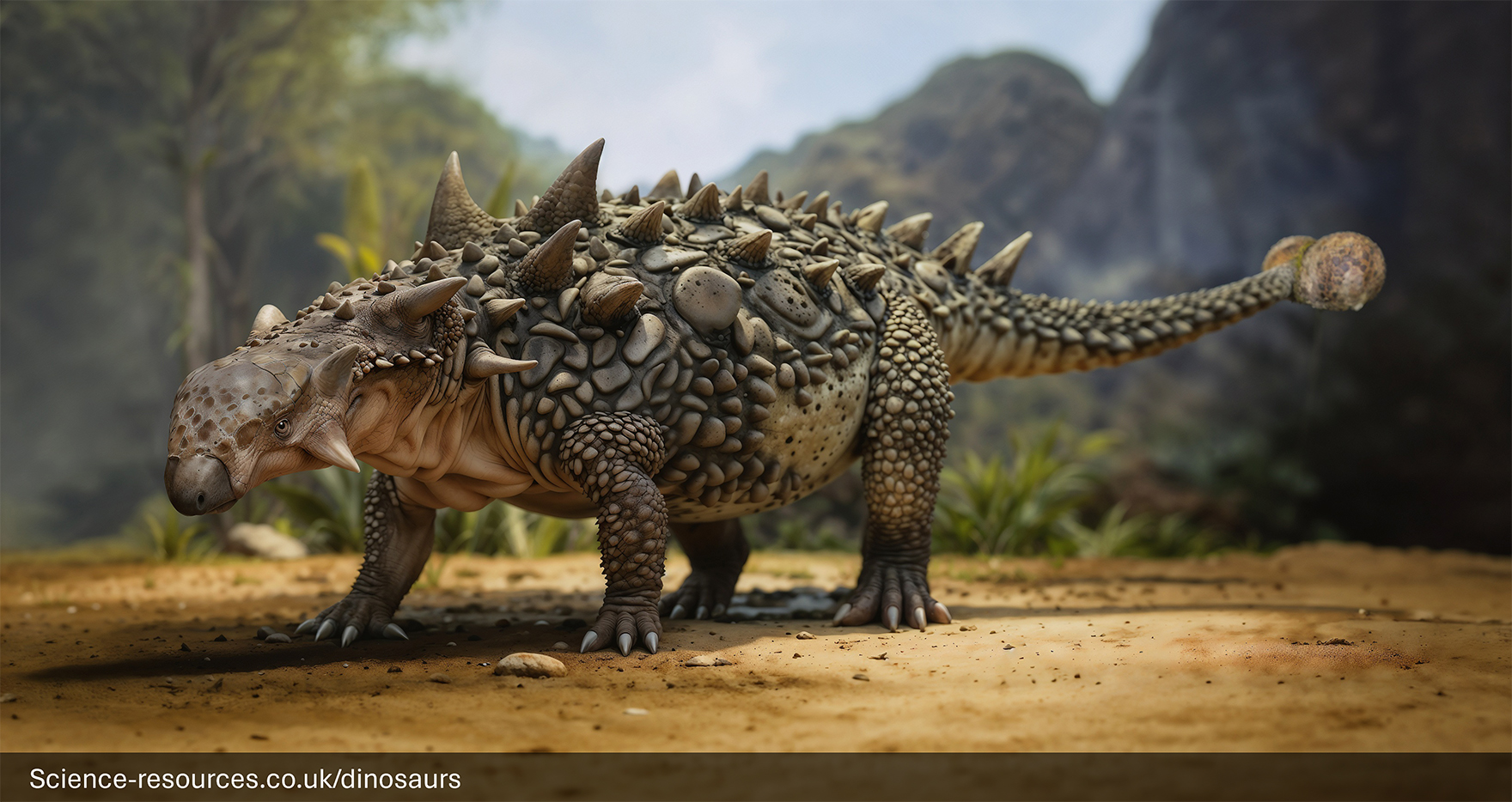Dinosaurs A:Z | E
You may also be intrested in: Free Dinosaur games
Dinosaurs: Euoplocephalus (Well-Armoured Head)
You may also be intrested in: Free Dinosaur games
Last updated: 12th Apr 2024 Euoplocephalus was a large, plant-eating dinosaur that lived during the Late Cretaceous period, about 100 to 66 million years ago. It was a well-armoured dinosaur known for its distinctive head and tail features.
Euoplocephalus had a heavily armoured body with bony spikes and plates covering its back and neck. Its head was well-protected with large horns and even bony plates over its eyelids. The tail ended in a heavy, club-like structure made of fused bones, used for defense. It walked on four legs, with the front legs being shorter than the rear ones. Generative AI Notification: Some elements of this image have been created or enhanced using AI technology. To find out how we create all our dinosaurs, click here. Euoplocephalus was a herbivore, meaning it only ate plants. It had a broad toothless beak for snipping leaves, and its jaws contained a single curved row of teeth for chewing plant material. Fossils of Euoplocephalus have been found in North America, particularly in the Canadian province of Alberta and the US state of Montana. They lived in areas with dense vegetation that provided plenty of food. • Euoplocephalus means "well-armoured head" because of the bony plates protecting its face. • It belonged to a group of dinosaurs called Ankylosaurids, known for their armoured bodies and club-like tails. • The first fossil evidence of Euoplocephalus was described in 1902 from a partial skeleton found in Alberta. • Scientists have discovered more than 40 specimens, including 15 nearly complete or partial skulls. What is Euoplocephalus?
How big was Euoplocephalus?
Appearance
 Euoplocephalus
EuoplocephalusWhat did Euoplocephalus eat?
Where did Euoplocephalus live?
Interesting facts
Pronounced: you-op-luh-SEF-uh-lus


Euoplocephalus Facts
Name Means: "Well-Armored Head"
Length: 23 ft. (7 m)
Height: 8 ft. (2.7 m)
Weight: 2 tons
Diet: Herbivore (Low-lying
Plants)
Time: Late Cretaceous - 76 million years ago
Habitat: Open
Woodland
Fossils Found: North America
Euoplocephalus belonged to a family of dinosaurs called Ankylosaurids. This group is known for their heavy armour and tail clubs. They are part of the order Ornithischia, which includes bird-hipped dinosaurs. Other members of this family included Tarchia, Talarurus and Ankylosaurus.
Euoplocephalus was a quadruped, meaning it walked on four legs. Its strong legs and armoured body made it well-suited for moving through dense vegetation.
Euoplocephalus had several unique features:
• Armoured head: Its head was covered with bony plates, including its eyelids.
• Tail club: The tail ended in a heavy club used for defense. • Spiked body: Bony spikes and plates covered its back and neck for protection.
Q1: What is a Euoplocephalus?
A1: Euoplocephalus was a large, armored dinosaur that lived during the Late Cretaceous period, around 76.4 to 75.6 million years ago. It is known for its heavy body armor and club-like tail.
Q2: How big was the Euoplocephalus?
A2: Euoplocephalus could grow up to 5.3 meters (17 feet) long and weighed about 2 metric tons (2.2 short tons).
Q3: What did Euoplocephalus eat?
A3: Euoplocephalus was a herbivore, meaning it ate plants. It likely fed on low-lying vegetation such as ferns and shrubs.
Q4: How did Euoplocephalus protect itself from predators?
A4: Euoplocephalus had thick, bony plates covering its body and a large, bony club at the end of its tail. It used these features to defend itself against predators like Albertosaurus and Gorgosaurus.
Q5: Where have Euoplocephalus fossils been found?
A5: Fossils of Euoplocephalus have been discovered in North America, particularly in Canada and the United States.
Q6: What makes Euoplocephalus unique among dinosaurs?
A6: Euoplocephalus is unique because of its extensive armor and its tail club, which it could swing to deliver powerful blows to predators. It also had a broad, flat body and short, sturdy legs.
Q7: How do scientists learn about Euoplocephalus?
A7: Scientists study fossils, including bones and sometimes skin impressions, to learn about Euoplocephalus. They also use modern technology like CT scans to examine the fossils in detail.
Q8: Did Euoplocephalus live alone or in groups?
A8: It's not entirely clear, but some scientists believe Euoplocephalus may have lived in small groups or alone, based on the fossil evidence.
Q9: What new discoveries have been made about Euoplocephalus?
A9: Recent studies have provided new insights into the diversity of ankylosaurid dinosaurs, showing that Euoplocephalus had several close relatives with similar features.
Q10: Why is Euoplocephalus important to study?
A10: Studying Euoplocephalus helps scientists understand more about the diversity of life during the Late Cretaceous period and how these amazing creatures adapted to their environments.
Which family of Dinosaurs did Euoplocephalus belong to?
How did Euoplocephalus move?
What were the unique features of Euoplocephalus?
Euoplocephalus FAQ
You may also be intrested in:
Tags: How big was Ankylosaurus, Ankylosaurus size, where does Ankylosaurus live, how tall are Ankylosaurus, what does Ankylosaurus mean, Ankylosaurus, Ankylosaurus facts
Tags: How big was Euoplocephalus, Euoplocephalus size, where does Euoplocephalus live, how tall are Euoplocephalus, what does Euoplocephalus mean, Euoplocephalus, Euoplocephalus facts